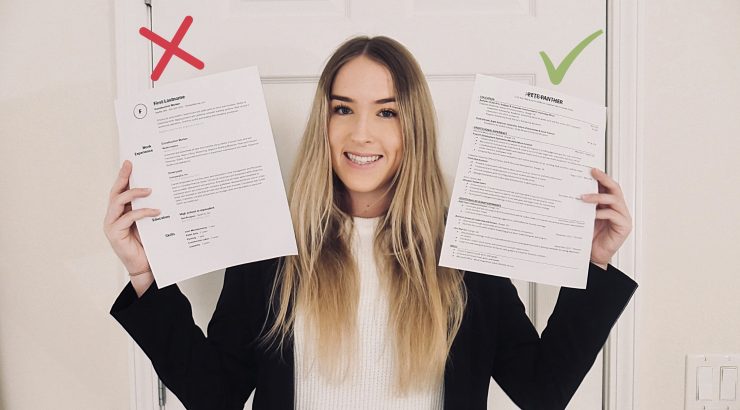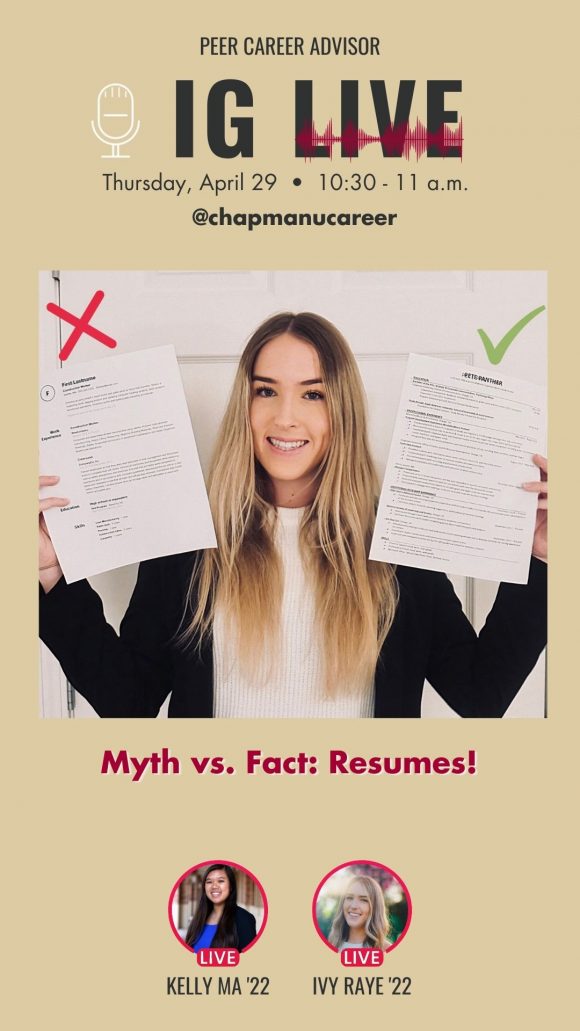
Myth vs. Facts: Resumes Here is a simple checklist to clean up your resume, no matter the occasion!
October 6, 2020

Watch the Career Peer Advisor IG LIVE conversation on this topic on @chapmanucareer IGTV
Resumes are single-handedly the most important document to have when it comes to your career and professional development. Check out these myths and facts regarding resumes to ensure your resume is employer-ready!
MYTH: I should use a pre-made template that I found on Microsoft or Google to format my resume.
It would be best to start from scratch when making your resume. If you don’t know where to start, we have a resume template that you can follow (that won’t negatively affect the AI systems).
Although this is a seemingly easy way to create a resume (in fact I did this myself in high school), it is not the recommended way to create a resume while in college. This is because most companies, especially very large companies that have many applicants, use Applicant Tracking Systems, computer programs that target certain words in the resume that coincide with the job description. Many of these systems cannot read pre-made templates, and if the system cannot find those exact words, the resume will be thrown out.
The templates that are provided also make it hard for the AI systems to look for words in general. The set-up of the template can make it hard to target those words, moving onto the next resume.
Another reason we recommend that you make your resume from scratch is because the pre-made templates can make it difficult to fit all your information on one page. This means you would have to cut down major information regarding your tasks at certain jobs, and run the risk of the resume being too vague. The pre-made templates are also notoriously hard to customize and edit, and since your resume is a living document, you want this process to be as easy as possible. Ideally, you will be constantly adding new experiences!
FACT: My resume should be one page.
Fast fact! The average time spent looking at a resume is less than 10 seconds, so you need to make it as easy to read as possible!
This is especially true if you are an undergraduate student. The only time your resume should be more than one page is a few years after you have graduated from undergraduate school and you’ve had some years of additional, relevant experience to add to your resume.
We recommend that your resume remain on one page because it makes it easier for employers to quickly read your resume. Most of the time, employers are doing just that — skimming your resume. This can be for many reasons: large pool of applicants, short on time, etc. It is important to keep it brief and sweet so employers can get a good grasp of who you are in the few moments that they look at your resume.
MYTH: I need to include my home address in the header of my resume.
Although a detail that was included quite often in the past, employers no longer require your physical home address. More than likely, you have already included this information somewhere during the application process.
Instead, we recommend that you include your personalized LinkedIn link in the header with your contact information, to give them more context about you and your location.
“But wait, what if I want them to know where I’m located so I don’t need to travel?” Great question! If you want the company to know that you are local, which is very popular among college students, you can include your [City Name, State] in the header, alongside your LinkedIn link. This can be quite handy if you are in different cities during the summer and school year. Providing this information can help employers know that you will be local for the duration of the position.
FACT: I should include my graduation date in my education section.
Instead of including the number of years you’ve been studying your course, include the month and year that you are expected to graduate. This can help keep your resume “short and sweet” (as mentioned earlier). Keeping it short and sweet helps employers use less time calculating when you’re expected to graduate and more time looking at your previous and current roles.
Employers knowing when you’re expected to graduate can positively benefit you because they’ll know when exactly you’ll be available for full-time roles at their company (since more than half of internships result in full-time job offers!).
MYTH: I need to include an objective statement on my resume.
Again, this is something that was very popular, even when I was in high school, but things have changed. Employers no longer look for objective statements because, if you are applying for a job or internship, they know that your main objective is to secure that specific job.
The only exception to this would be if the employer has stated in the job description that they require an objective statement on the resume (and there are certain employers who do, so pay attention to the job description!)
If having your career objective be known is important for you, you can include it in your LinkedIn headline or “about” section. Once you include your LinkedIn link in the header of your resume, the employers can see what your main objective is the minute they view your LinkedIn profile.
And a bonus? Getting rid of the objective statement on your resume gives you more space to write about all of your experiences and accomplishments! (And maybe even add additional ones you didn’t think you had room for!)
FACT: I should order my experiences from most recent to oldest.
Formatting your previous and current job roles by the most current to the oldest can help employers focus on that current job and the tasks that you’ve completed most recently- the tasks that are the freshest.
This remains true for all experiences including paid roles, leadership roles, volunteer experience, and freelance work.
MYTH: I need to include references or “References Available Upon Request” on my resume.
Reminder: Before you give away anyone’s personal information as a reference, make sure you confirm with them that you are able to list them as a reference to potential employers. Always notify them when you have done so.
Not only should you NEVER include direct reference names and contact information on your resume, you don’t actually need to include any references on your resume. Similarly to your home address, references are not needed on your resume because you have most likely included it somewhere else during the application process (or the employer will specifically ask for it at that stage in the hiring process).
The only time you will include reference names and contact information is if the employer asks, and you won’t add it to your resume. Instead, you may need to submit a letter of recommendation written by them along with your resume, or the employer will ask you for the references contact information themselves.
FACT: I should include volunteer experience on my resume.
This remains true for all experiences that are unpaid. Paid roles are not the only thing you include on your resume. Including volunteer experiences and leadership roles show employers that you can take on multiple roles and tasks. Participating in other roles outside of your main job is a great way to show how you get involved.
If the company is one that believes in connecting with the community, volunteer experience can also help you connect to the company and their mission statement, culture and values.
MYTH: I should include both hard and soft skills on my resume.
Including soft skills in the skills section of your resume is a common misconception among students. Before we talk about what you should include in the skills section of your resume, let’s distinguish the difference between soft and hard skills.
Soft skills are skills that are non-technical skills that relate to how you work. This can include interpersonal skills, time management skills, communication skills, and skills regarding answering phone calls and emails. Instead of including these in the skill section of your resume, we recommend that you express these non-technical skills in the tasks under each job role.
As for hard skills, these are what should be included in the skills section of your resume. They include technical skills such as editing software, web applications that you have experience using, languages you speak, etc.
Including the hard skills in your skills section can help employers distinguish between potential hires and non-potential hires by the programs they know how to use that will be required within the job. (They are also great keywords that the previously mentioned Applicant Tracking Systems can pick up on!)
FACT: I should start every bullet point with a past-tense action verb, despite being a current role.
Reminder: Try not to use the same action verb more than once. If you need to include it more than once, narrow it to only two instances and don’t use it back to back. For example, don’t have two sentences next to each other starting with the same action verb.
No matter if the role is a current or previous one, it is always important to start each bullet point for your tasks with a past-tense action verb. The reason for this is because every task you include should be one that has been completed within the role.
You should NEVER include a task that you haven’t completed within the position. The last thing you want is to have the employer think you have experience with a task when you’ve never done it.
If you need help coming up with action verbs for your previous roles, here is a list of possible action verbs to use.